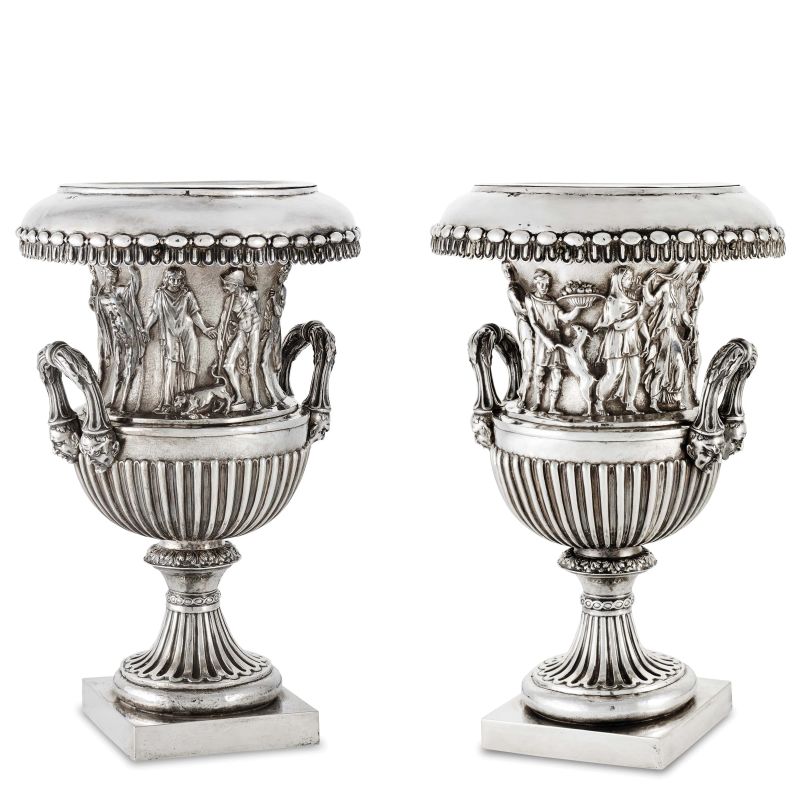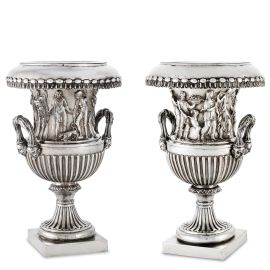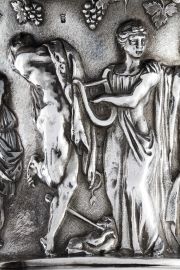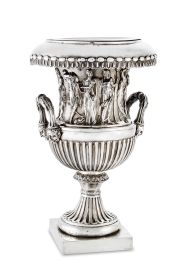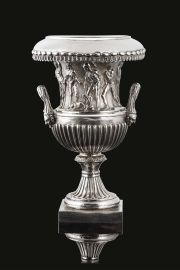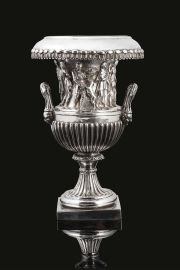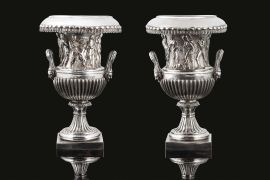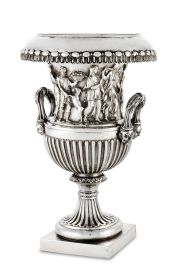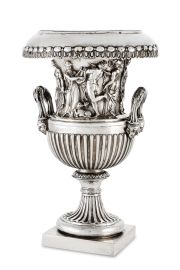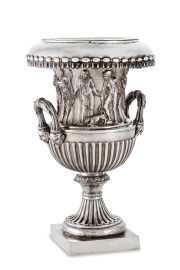‘Trofeo’ workshop, Venice; second quarter, 18th century. Silversmith: probably Andrea Fulici, assayer: Zuanne Cottini
‘Trofeo’ workshop, Venice; second quarter, 18th century. Silversmith: probably Andrea Fulici, assayer: Zuanne Cottini
A PAIR OF KRATER VASES
Height 41.5 cm; Diameter 27 cm; combined weight 5830 g (2)
In both cases, the fluted foot of the krater rests on a square base, the fluting on the rather long foot terminates in a band with baccellato decoration and the fillet is decorated with chased leaves and interlinked elements. Each piece has two external handles, the lower extremities of which are in the form of satyrs crowned with ivy and the tops adorned with leaves. The bodies are decorated with embossed representations of Dionysian processions.
On the first vase, the meeting of Ariadne and Dionysus at Naxos is depicted underneath a vine shoot running under the lip. The god is portrayed in the midst of his retinue with Maenads, satyrs, panthers, armed figures and a female figure playing a lyre (the Muse Terpsichore?).
On the second vase, again under a grapevine, is another representation of a Dionysian procession with satyrs, Maenads, and panthers associated with other mythological figures; in particular, an armed Athena and an Artemis who restrains a little goat with one hand and, exceptionally, holds a bowl of fruit in the other. There follow three female figures, two of which could be identified as Demeter and Persephone. The latter raises a corner of her veil with one hand. Like the first-mentioned piece, this vase also portrays a female figure playing the lyre (the Muse Terpsichore?).
The lips of both vases are outlined by ‘necklaces’ of ovoid and baccellato elements.
Besides the 18th-century Venetian hallmark, both vases display the Dutch import mark applied to works in silver of foreign manufacture in use from 1814 until 1953.
The form and decoration of the two works are modelled after the marble kraters of the Neo-Attic period. The most majestic reference as concerns the form is doubtless the Medici Vase, although another important reference is surely the Borghese Vase, of which our pair copies both the krater form and the decoration with its frieze of Maenads, mythological figures and panthers dancing in a Dionysian procession.
The two magnificent marble vases mentioned above are examples of the Neo-Attic style in sculpture in favour with the well-to-do Roman art clientele from the 2nd cent. BCE to the 2nd cent. CE.
Today, these vases are at the Galleria degli Uffizi and the Musée du Louvre, respectively.
The Medici Vase, found in a thousand pieces on Rome’s Esquiline hill in the 1500s, was purchased by the Medicis at the end of the century for their Roman villa; it came to the Uffizi in 1780. The frieze decorating this elegant vase narrates a mythological scene, probably the council of the Achaeans in Delphi on the eve of the Trojan War.
The admiration aroused by this work was such that, over the course of the 17th and 18th centuries, a dialogue with the ancient world took form in myriad copies in the most disparate materials, from marble to bronze. The vase was also reproduced in many prints and drawings that circulated through Europe and provided models to be imitated in accordance with the prevailing taste for the golden age of the Roman Empire. Mention must be made, in this connection, of Stefano della Bella’s etching Il Vaso Medici con Cosimo III, from 1656 (FIG. 1).
The Borghese Vase was, in turn, a significant model for the silversmiths who crafted the two kraters up for auction today. The krater form and the decorative subjects emulate the vase now at the Louvre: from the vine shoot under which the satyrs and the sinuously elegant Maenads dance in the retinue of the powerful mythological figures, to the fluted and baccellato foot and to the ivy-crowned satyrs supporting the handles, everything in the two vases speaks of a taste that looks to the great culture of ancient Rome. Like in the case of the Medici Vase, numerous reproductions of the Borghese Vase were created after the 1500s, in various materials, according to the same logic of continuity that was seen as linking ancient to modern culture.
We may thus say that the pair of silver kraters proposed by the Capolavori da Collezioni Italiane auction is one example of the many manifestations of the taste common to all parts of the Europe of their time, for the ancient and for a type of art symbolic of an age of great cultural and political splendour.
Provenance
Private collection
Comparative Bibliography:
P. Pazzi, I punzoni dell'argenteria veneta, Tomo I, Venezia e Dogado (Venice, 1992), p. 138, no. 420; p. 145, no. 452.
A. Coliva; M. L. Fabréga-Dubert; J. L. Martinez; M. Minozzi, I Borghese e l'antico. Catalogue of the exhibition: Rome, Galleria Borghese, 7 December 2011 - 9 April 2012 (Milan, 2011).

